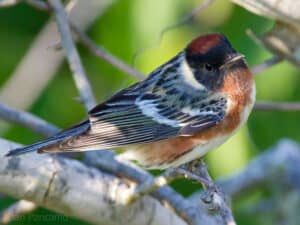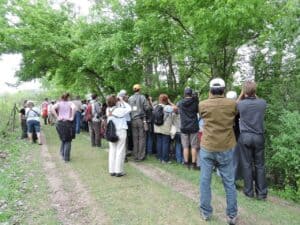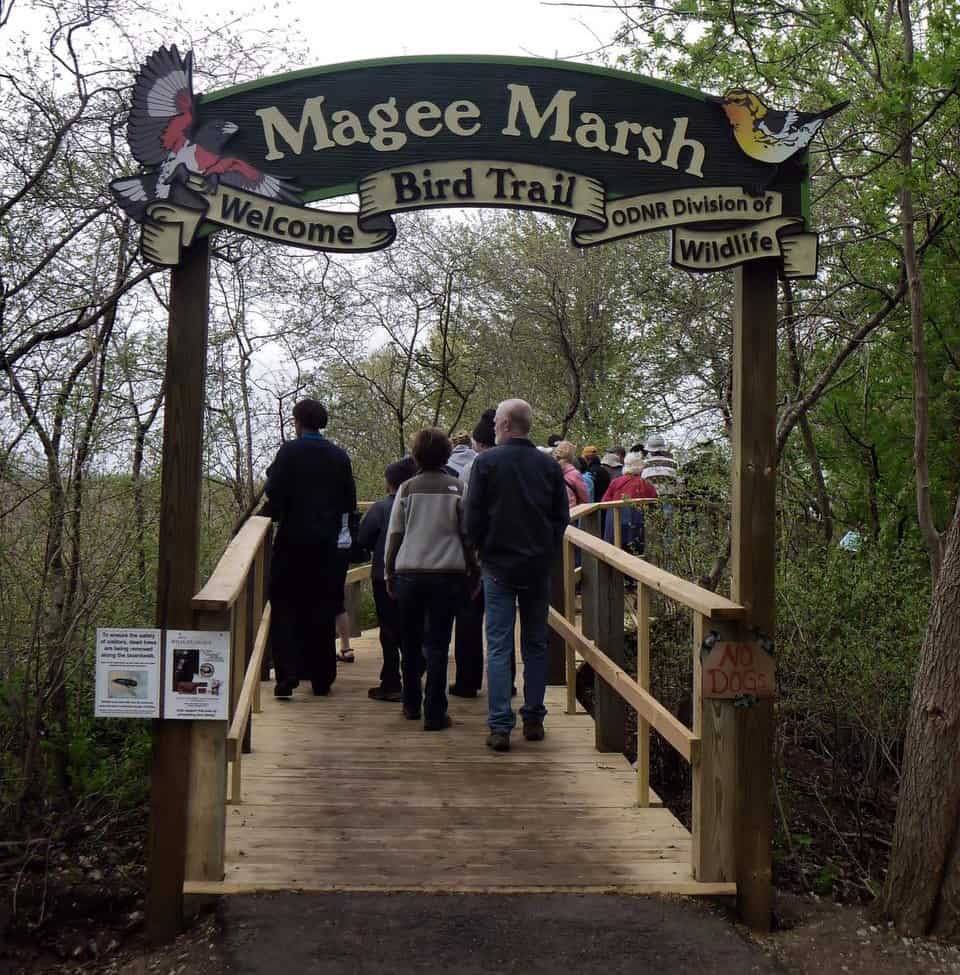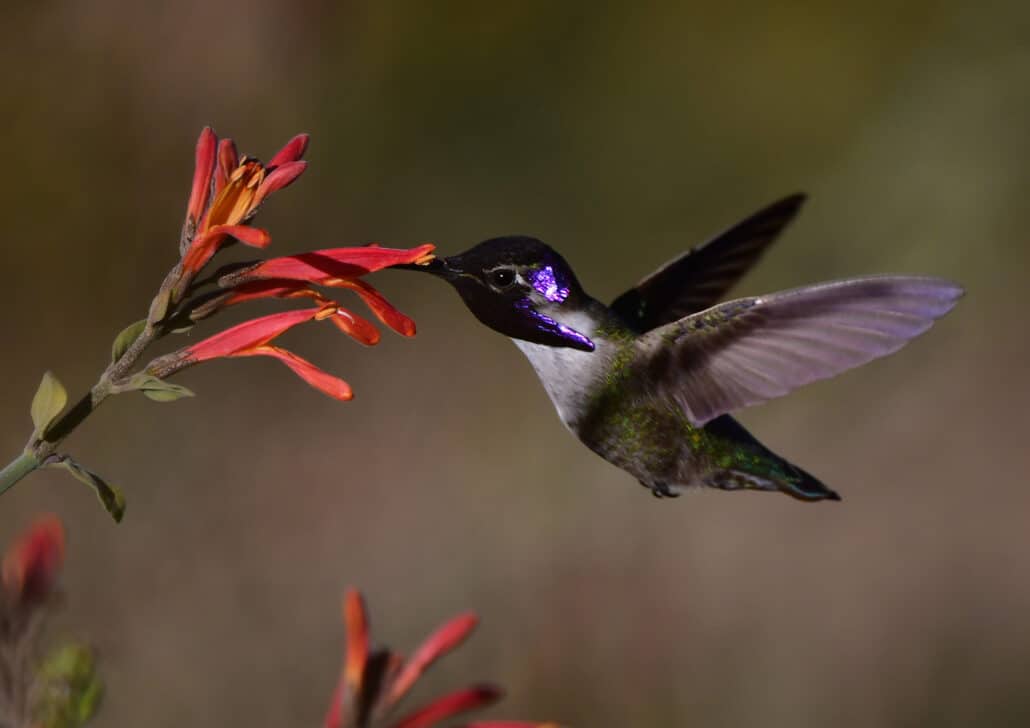Just east of the Panama Canal, near the village of Gamboa, a small songbird with russet and black markings forages in the lush tropical vegetation. For several weeks, the bird, spurred by an unusual sense of hunger, has been feeding ravenously on the tiny abundant insects common to the rainforest. The bird, an adult male bay-breasted warbler, now weighs significantly more than when he arrived here a little over five months ago, and this additional weight, in the form of fat, will be of crucial importance over the next few weeks. The next evening, as the sound of a Greek bulk freighter’s horn echoes across the darkening backwaters of Gatun Lake, the warbler takes flight on a southerly wind and wings north.

After a long and arduous two-day flight (because the winds changed direction in the early morning hours of the second night), the bay-breasted alights in a patch of scrubby lowland jungle. Nearby, a busload of tourists embarks on a guided tour of the ruined Mayan city of Ek Balam, but the bird takes little note, instead associating with a small group of northern waterthrushes and Tennessee and magnolia warblers. The mixed flock forages in the flowering trees and stores energy for the next stage of their collective journey.
As night falls, a light southerly wind beckons, and the warbler, along with scores of other northbound migrants, leaves the Yucatan jungle behind and faces an 18- to 22-hour flight that most humans find incredible: an open-water crossing of about 500 miles by an animal that weighs only slightly more than 12 grams. But the bird wings on, following a path blazed by ancestors thousands of generations before. The path takes the warbler across the Gulf of Mexico, the blackness below dotted here and there by brilliant jets of flame as waste gases burn off from oil platforms hundreds of feet below. Some birds become distracted by these bright beacons of light and lose their way, but the bay-breasted has crossed the Gulf before and ignores the lights below, focusing solely on gaining latitude on the journey north.
A week later, after casually moving with the pace of spring foliage across the Deep South and into the Midwest, the bird encounters an obstacle that halts migration for the night. Just after the bay-breasted begins to cross the third and final significant body of water on its journey, a series of thunderstorms coalesce into an organized front that brings gusting north winds and heavy precipitation. The warbler drops below the scudding cloud deck and retreats back to the south in search of a suitable place to ride out the inclement weather. Just inland from the Lake Erie shoreline, a patch of greening foliage beckons, and the bird, along with a dozen others faced with the same choice, drops into the welcoming tangles of the woodlot.
As the sun rises, the warbler begins to forage low in the understory, because here there are plenty of small insects to enjoy, and up higher—where the bay-breasted often feeds—the leaves of spring have yet to unfold. Just over a dozen feet away from the feeding warbler, a small boy of 13 stands on a raised wooden boardwalk and raises his new pair of binoculars to gaze in wonder at the brightly colored jewel. Ever since his grandmother presented him with a field guide to birds and the binoculars for his birthday last month, the boy had been looking forward to the promised weekend visit to a place his dad heard was good for birds in the spring. This moment would be the genesis of a lifetime hobby for the boy, who, at this point, is being jostled by a group of local birders, who, in their excitement over a smartly plumaged Wilson’s warbler, fail to notice the lad. When he regains his footing and refocuses his binoculars, the bay-breasted is gone, but soon a brilliant male Cape May warbler moves into view, the second of 19 warbler species he will see that morning.
The bay-breasted, completely unaware of the impression it made on the young birder, feeds for another day before winging north and east across Lake Erie and into Canada. By sunrise it has settled into a patch of boreal forest just west of Lac Saint-Jean in Quebec and begun singing, for a new nesting season has begun.
The boy, the warbler, and the church group all converged on the wooden boardwalk at Magee Marsh Wildlife Area in Ottawa County, Ohio, during mid-May. This boardwalk may be the most famous spot in North America from which to watch the parade of Neotropical migrant passerines in spring, and hundreds to thousands of birders from all across the United States, Canada, and beyond come to be entertained by the show. In years past, Point Pelee, just across the lake in Ontario, enjoyed a reputation as “the place to be,” but birding conditions on the narrow, triangular peninsula jutting south into Lake Erie are highly dependent on weather, whereas the spectacle at Magee Marsh is generally more predictable and produces a steadier flow of birds. High Island, Texas, may produce better birding during fallout conditions, but visitors are equally likely to encounter relatively quiet woodlands when weather conditions are not conducive to trans-Gulf migrants stopping as soon as they reach shore. For the traveling birder who must plan a visit before local weather conditions are known, Magee Marsh offers an excellent opportunity to view spring-plumaged warblers, tanagers, thrushes, vireos, cuckoos, and more.

In addition to excellent diversity (many days in May produce 25 or more species of warbler), the birding itself is quite easy. A flat half-mile raised wooden boardwalk with handrails winds through a woodlot set just back from the shore of Lake Erie. And this woodlot is often chock-full of birds. The boardwalk features benches spaced along its length and is wheelchair accessible. Especially during early to mid-May and during times of inclement weather, the birds forage close to the ground, making for easy viewing. In many cases, the birds are so close that binoculars are useless, and on a recent visit, we were able to take rather decent photographs of warblers with smartphones, devices not known for their telephoto capabilities.
About the only issue with birding along the boardwalk is that it can get crowded—extremely crowded! The apex of spring migrant passage through northern Ohio occupies a fairly short portion of the May calendar, and numbers of birders peak with the anticipated maximum flights of birds. On these days it can be hard to move even a few yards along the boardwalk, but the birding is not as closely tied to the time of day as in some locations, so arriving very early or visiting later in the day, when some of the crowds have dispersed, may be rewarding. On a recent visit in the late-teens of May, we had no issues with crowds and were able to move about freely. However, reports from the previous week, when the Biggest Week in American Birding festival was in full swing, indicate the crowds at that time were elbow-to-elbow in spots.

Choosing the best time to visit Magee Marsh depends somewhat on the expectations and hopes of the traveler. Migration varies from year to year, so the results of previous years may not necessarily reflect future conditions, but in general, the maximum number and diversity of birds occurs somewhere around the second week of May. Some years feature a steady flow of birds, with few peaks and valleys, whereas others have waves of birds arriving and departing. But in most cases, the numbers and diversity of birds will impress visitors. Birders hoping to find uncommon and highly sought after species such as Connecticut, mourning, and Kirtland’s warblers may wish to visit slightly later—the second through third week of May—as earlier in the month may be too early for these later-arriving species. A later visit also increases the chances to see numbers of boreal breeding birds, including bay-breasted and blackpoll warblers. Several online resources provide week by week and species by species information, so that visiting birders can tailor their trip to the birds they most want to see. Good places to start research are mageemarsh.org and biggestweekinamericanbirding.com.
Logistically, visiting the western lakeshore of Ohio in mid-May entails few problems. Aviators can choose to fly into a variety of nearby airports including Detroit, Cleveland, Akron-Canton, and Toledo.
Magee Marsh itself is not particularly close to any significant lodging, but both Port Clinton and Toledo are less than a half-hour’s drive to the east and west, respectively. Hotels often sell out during the busy birding season, so book early to avoid disappointment. Most of the major chains, as well as some enchanting local establishments, have properties within a short drive of Magee Marsh.
Similarly, restaurants are not abundant near the major birding areas, so travelers may wish to pack a lunch to enjoy at the wildlife area. Considering that we saw more than 15 species of warblers from our picnic table, this might not be a bad choice. Otherwise, eateries abound in both Port Clinton and the townships bordering Toledo. For a quick lunch option, a popular submarine chain shares an outlet with a local grill featuring fish, burgers, and sandwiches just 12.7 miles west of Magee Marsh on Ohio Route 2.
Birding in the area is by no means restricted to the Magee Marsh boardwalk. The Magee Marsh Wildlife Area and adjacent Crane Creek Wildlife Area feature a number of walking trails, and the road leading to the lakeshore passes through productive wetland areas where nesting trumpeter swans and sandhill cranes might be glimpsed, along with lingering and breeding waterfowl and migrating shorebirds. Just to the west of Magee Marsh is Ottawa National Wildlife Refuge, offering 10 miles of walking trails and an auto-tour route that takes visitors by impoundments and wetlands. Bitterns, rails, waterfowl (including the reintroduced trumpeter swan) and migrant shorebirds are all possibilities, and on a recent visit, we enjoyed rare-for-the-area eared grebe and yellow-headed blackbird. Birders can stop in at visitor centers at Magee Marsh, Ottawa NWR, and Black Swamp Bird Observatory (located at the entrance to Magee Marsh) for up-to-date birding news.
Continuing west toward Toledo, both Metzger Marsh Wildlife Area and Maumee Bay State Park offer birding opportunities, including the chance to pad trip lists with water birds and raptors. Detailed descriptions and maps of these areas and others along the lakeshore can be found online here.
Birders wishing to pair a trip to Magee Marsh with one to Point Pelee, Ontario, can easily visit both locations during a single trip. Drive time from one to the other is just about two hours, presuming there are no significant delays at the United States–Canada border.
A visit to the western Lake Erie shore in Ohio during late April to late May should impress even the most jaded birder. Whether new to the hobby, an “old-timer,” a warbler fanatic, or just someone who enjoys birds, the Magee Marsh boardwalk and adjacent areas promise life-long memories and the opportunity to mingle with hundreds of like-minded folks. I hope you have a chance to visit and see for yourself the magic of Magee.




